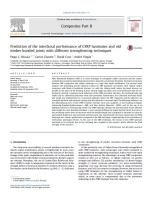Prediction of the interfacial performance of CFRP laminates and old timber bonded joints with different strengthening techniques
- Citation:
- Prediction of the interfacial performance of CFRP laminates and old timber bonded joints with different strengthening techniques, Biscaia, Hugo C., Chastre Carlos, Cruz David, and Viegas André , Composites Part B: Engineering, 1/1/, Volume 108, p.1-17, (2017) copy at https://docentes.fct.unl.pt/cmcr/publications/prediction-interfacial-performance-cfrp-laminates-and-old-timber-bonded-joints-dif

Abstract:
Fiber Reinforced Polymers (FRP) is a recent technique to strengthen timber structures and the studies available discussing the debonding between these materials are limited. Therefore, the bond assessment between FRP composites and timber substrates is a topic that needs clarification. The present work analyses the debonding process between Carbon (C) FRP laminates and timber with rupture modes consistent with Mode II interfacial fracture, i.e. with the sliding mode where the bond stresses act parallel to the plane of the bonding surface. Several single-lap shear tests were performed and the experiments showed a nonlinear local behaviour of the CFRP-to-timber interface. An interfacial bond-slip model and its calibration procedure were also presented. Furthermore, the calibrated nonlinear bond-slip model was implemented in a numerical approach where the FRP composite and the adhesive are simulated by linear and nonlinear springs and the substrate is assumed rigid. The following influences on the debonding process of the CFRP-to-timber interface were also analysed: (i) the bonding technique (Externally Bonded Reinforcement - EBR; and Near Surface Mounted - NSM); and (ii) the use of an additional device to mechanically anchor the CFRP laminate. Besides the determination of the effective bond length for each bonding technique, a new concept defining the length beyond which the force at the anchorage device does not decrease with the bonded length and a proposal to estimate its value for any bonded length was also presented and discussed. The experimental tests have shown that the NSM technique has a better performance compared to the EBR technique, independently of the installation of mechanical anchorage devices. In the case of the EBR technique, the strains in the CFRP laminate increased at its vicinities due to the clamping force applied to the anchors, which affected the final strength of the interface.
Notes:
n/a

